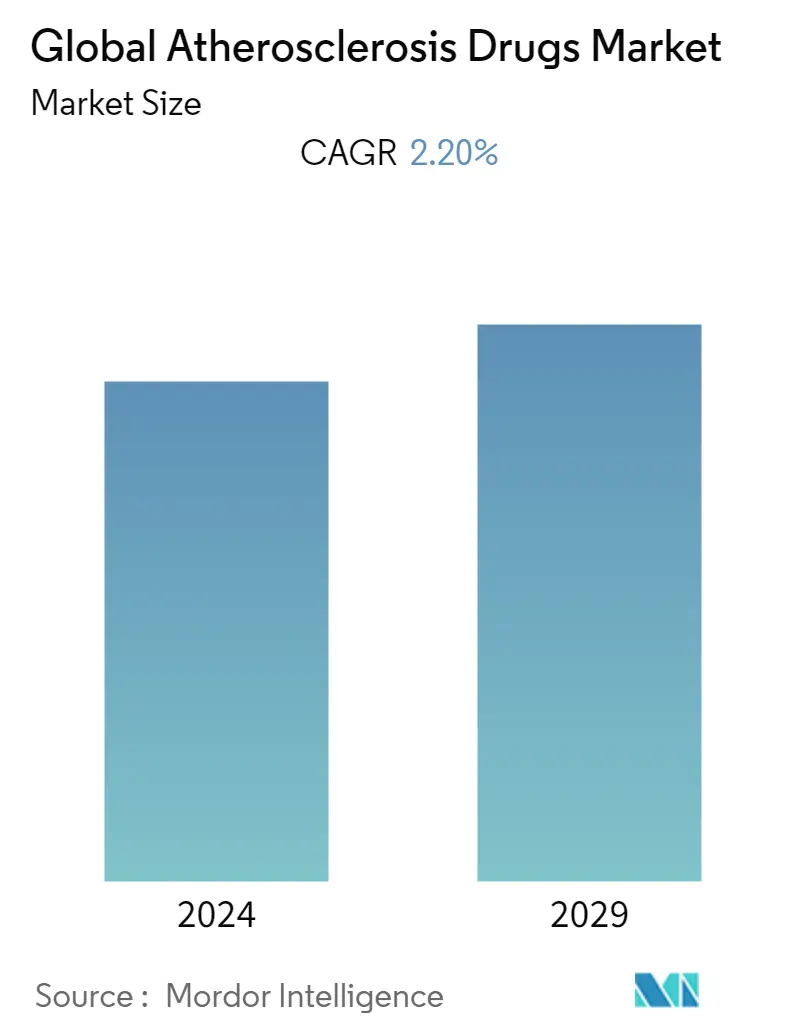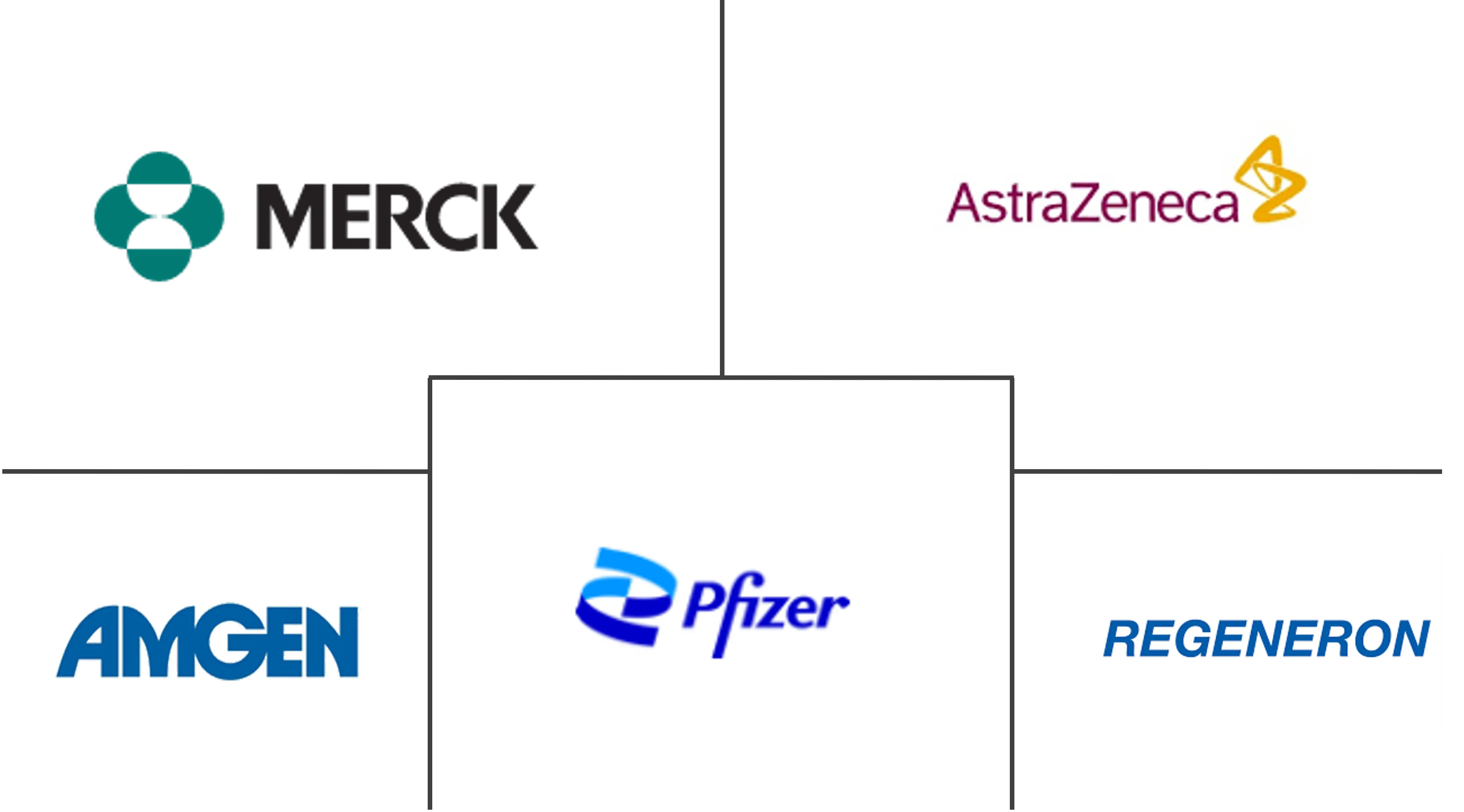Market Size of Global Atherosclerosis Drugs Industry

| Study Period | 2019 - 2029 |
| Base Year For Estimation | 2023 |
| Forecast Data Period | 2024 - 2029 |
| CAGR | 2.20 % |
| Fastest Growing Market | Asia Pacific |
| Largest Market | North America |
Major Players
*Disclaimer: Major Players sorted in no particular order |
Atherosclerosis Drugs Market Analysis
The Atherosclerosis Drugs Market is projected to register a CAGR of 2.2% during the forecast period (2022-2027).
In the COVID-19 pandemic, it was known that the lung was the primary organ to be affected; however, recent research indicates that SARS-CoV-2 infection can result in vascular illness. Chronic endothelial inflammation causes atherosclerosis by disrupting the delicate homeostasis of endothelial cells, which includes the hemostatic balance, inflammatory response, and vasomotor tone, among other features. The unregulated immunological environment created by the underlying endothelial dysfunction may be optimal for SARS-CoV-2 to cause a "cytokine storm" with severe clinical symptoms. Given that COVID-19 and atherosclerosis follow similar biological processes, targeted therapy has centered on preventing critical proteins from becoming activated. Drugs that target cytokines specifically are currently too expensive and far from being mass produced, despite the possibility that the results are positive. Statin treatment and other anti-platelet and anti-inflammatory medications, however, may act as a barrier against thrombotic problems following COVID-19. These abovementioned factors significantly drive the market in the pandemic conditions.
The major factor attributing to the growth of the market is the increase in the prevalence of atherosclerosis and cardiovascular diseases. According to the National Center for Chronic Disease Prevention and Health Promotion, Division for Heart Disease and Stroke Prevention, data updated in July 2022, about 697,000 people in the United States died from heart disease in 2020, that's 1 in every 5 deaths. One person dies every 34 seconds in the United States from cardiovascular disease. The maximum incidences of cardiovascular diseases can be attributed to the sedentary lifestyle in developed countries. The sedentary lifestyle leads to a high prevalence of high blood pressure, high cholesterol, obesity, and high alcohol consumption, which together contribute to a high incidence of cardiovascular diseases. Therefore, the sedentary lifestyle leading to a high prevalence of cardiovascular diseases and increasing awareness of the treatment options are expected to drive the market studied. The prevalence and incidence of cardiovascular problems are increasing because of plaque formation, which is driving up the demand for new treatment alternatives. In June 2022, a novel polymer created by Ben-Gurion University (BGU) and the Sheba Medical Center is called an E-selectin-targeting polymer. By lowering and avoiding plaque development, it is a novel treatment for atherosclerosis that lowers the risk of ischemia, stroke, arterial thrombosis, and myocardial infarction. An intense statin therapy called Protein Convertase Subtilisin/Kexin type 9 (PCSK 9) lowers low-density lipoprotein cholesterol levels, which lowers the risk of coronary atherosclerotic plaque development. The development of the global market for atherosclerosis medications is projected to be fueled by new treatments for atherosclerosis.
The rising intake of cholesterol-lowering medications by patients to lessen artery blockages is responsible for this market expansion. Consumers who lead demanding, yet sedentary lifestyles tend to choose short meals, which is expected to open new revenue opportunities for the atherosclerosis drug industry. Additionally, global government initiatives have been essential in raising the standard of healthcare services and infrastructure, which has prompted pharmaceutical corporations to create efficient medicines for the treatment of a variety of disorders. Drugs for atherosclerosis have been selling well because of their efficiency and ease of accessibility thanks to efficient distribution systems.
However, low diagnostic rates and the availability of generic products are the factors expected to restrain the market growth during the forecast period. Due to several recalls of valsartan products made by various companies, the United States Food and Drug Administration approved a unique generic version of Diovan in March 2019 to close the high demand and limited supply gap of this crucial medication. After two months, Zydus Cadila declared that Chlorthalidone, a Pfizer-produced generic counterpart of Thalitone, had been approved.
Atherosclerosis Drugs Industry Segmentation
As per the scope of the report, atherosclerosis is a hardening and narrowing of your arteries. It puts blood flow at risk as arteries get blocked. The Atherosclerosis Drugs Market is segmented by Drug Class (Anti-platelet Medications, Cholesterol-Lowering Medications, Fibric Acid and Omega-3 Fatty Acid Derivatives, Beta Blockers, Others) Distribution Channel (Retail Pharmacies, Hospital Pharmacies, and Online Pharmacies), and by Geography (North America, Europe, Asia-Pacific, Middle East & Africa, and South America). The market report also covers the estimated market sizes and trends for 17 different countries across major regions, globally. The report offers the value (in USD million) for the above segments.
| By Drug Class | |
| Anti-platelet Medications | |
| Cholesterol Lowering Medications | |
| Fibric Acid and Omega-3 Fatty Acid Derivatives | |
| Beta Blockers | |
| Others |
| By Distribution Channel | |
| Retail Pharmacies | |
| Hospital Pharmacies | |
| Online Pharmacies |
| Geography | ||||||||
| ||||||||
| ||||||||
| ||||||||
| ||||||||
|
Global Atherosclerosis Drugs Market Size Summary
The Atherosclerosis Drugs Market is experiencing growth driven by the increasing prevalence of atherosclerosis and cardiovascular diseases, largely attributed to sedentary lifestyles in developed countries. This lifestyle leads to high blood pressure, high cholesterol, obesity, and increased alcohol consumption, contributing to the rise in cardiovascular conditions. The market is further propelled by the development of new treatments and drugs, such as PCSK9 inhibitors, which significantly lower LDL cholesterol levels and reduce the risk of coronary atherosclerotic plaque development. The COVID-19 pandemic has also influenced the market, as research indicates a link between SARS-CoV-2 infection and vascular illness, prompting interest in targeted therapies and the use of statins and other anti-platelet and anti-inflammatory medications to mitigate thrombotic complications.
North America is expected to dominate the atherosclerosis drugs market due to the high prevalence of cardiovascular diseases, a well-established healthcare infrastructure, and the presence of key industry players. The United States, in particular, holds a significant share of the market, supported by favorable healthcare policies and a large patient population. The market is moderately competitive, with major companies like Pfizer Inc., AstraZeneca, and Merck & Co., Inc. leading the charge. Despite challenges such as low diagnostic rates and the availability of generic products, the market continues to expand, driven by government initiatives, research partnerships, and the approval of novel cholesterol-reducing drugs.
Global Atherosclerosis Drugs Market Size - Table of Contents
-
1. MARKET DYNAMICS
-
1.1 Market Overview
-
1.2 Market Drivers
-
1.2.1 Increase in Prevalence of Atherosclerosis & Cardiovascular Diseases
-
1.2.2 Rising Awareness about Cardiovascular Diseases
-
-
1.3 Market Restraints
-
1.3.1 Low Diagnostic Rate
-
1.3.2 Availability of Generic Products
-
-
1.4 Porter's Five Force Analysis
-
1.4.1 Threat of New Entrants
-
1.4.2 Bargaining Power of Buyers/Consumers
-
1.4.3 Bargaining Power of Suppliers
-
1.4.4 Threat of Substitute Products
-
1.4.5 Intensity of Competitive Rivalry
-
-
-
2. MARKET SEGMENTATION (Market Size by Value - USD million)
-
2.1 By Drug Class
-
2.1.1 Anti-platelet Medications
-
2.1.2 Cholesterol Lowering Medications
-
2.1.3 Fibric Acid and Omega-3 Fatty Acid Derivatives
-
2.1.4 Beta Blockers
-
2.1.5 Others
-
-
2.2 By Distribution Channel
-
2.2.1 Retail Pharmacies
-
2.2.2 Hospital Pharmacies
-
2.2.3 Online Pharmacies
-
-
2.3 Geography
-
2.3.1 North America
-
2.3.1.1 United States
-
2.3.1.2 Canada
-
2.3.1.3 Mexico
-
-
2.3.2 Europe
-
2.3.2.1 Germany
-
2.3.2.2 United Kingdom
-
2.3.2.3 France
-
2.3.2.4 Italy
-
2.3.2.5 Spain
-
2.3.2.6 Rest of Europe
-
-
2.3.3 Asia-Pacific
-
2.3.3.1 China
-
2.3.3.2 Japan
-
2.3.3.3 India
-
2.3.3.4 Australia
-
2.3.3.5 South Korea
-
2.3.3.6 Rest of Asia-Pacific
-
-
2.3.4 Middle East and Africa
-
2.3.4.1 GCC
-
2.3.4.2 South Africa
-
2.3.4.3 Rest of Middle East and Africa
-
-
2.3.5 South America
-
2.3.5.1 Brazil
-
2.3.5.2 Argentina
-
2.3.5.3 Rest of South America
-
-
-
Global Atherosclerosis Drugs Market Size FAQs
What is the current Global Atherosclerosis Drugs Market size?
The Global Atherosclerosis Drugs Market is projected to register a CAGR of 2.20% during the forecast period (2024-2029)
Who are the key players in Global Atherosclerosis Drugs Market?
Pfizer Inc., AstraZeneca, Merck & Co., Inc. , Amgen Inc. and Regeneron Pharmaceuticals, Inc. are the major companies operating in the Global Atherosclerosis Drugs Market.

